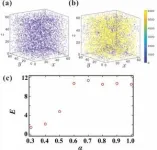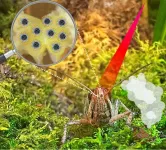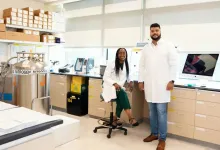(Press-News.org)
Tokyo, Japan – Scientists from Tokyo Metropolitan University have been studying the strength and toughness of sand columns made of a mixture of sticky and non-sticky grains. They have uncovered the mechanism behind how the strength changes as grains are mixed in different ratios, and how a mixture can help keep the column more resilient to deformation. Non-sticky grains are also easily replaceable with other materials, enabling the design of stronger, tougher, functional matter.
Granular matter consists of vast numbers of small grains, like sand and powders. Such grains can be made to stick to each other, yielding strong materials like concrete. But strength isn’t everything. Strong materials can be brittle, and easily crack when deformed. Science-driven design of materials which are not only stronger but tougher too continues to be a challenge for material scientists.
A team from Tokyo Metropolitan University led by Professor Rei Kurita have been studying the mechanical properties of sand columns, a simple yet powerful model for granular matter. Instead of focusing on grains which all stick to one another, they have been looking at mixtures of non-sticky normal sand and “kinetic” sand, silicone-oil coated grains which can stick to each other. While the mechanics of “attractive grains” is relatively well understood, that cannot be said for materials where stickiness only features in a subset of grains.
When they made columns with different proportions of sticky grains, they found that the strength of the column, as characterized by how much they deform when put under a load, shows a characteristic stepped change. When the proportion of sticky sand reaches 60%, the strength suddenly jumps to a higher value. More sticky sand does not lead to any further increase. Through computer simulations of a similar setup, they found that this was exactly when sticky grains formed a rigid network which extended through the sample. This needs to be distinguished from sticky grains simply connecting through the sample; lines of sticky grains, for example, can easily deform when the ends are pushed together. It is only when there are enough connections between grains that the sticky grains can support a weight.
Unlike typical strong materials however, these partially sticky columns show unique behavior when they are put under larger loads. As the column deforms, the columns don’t crack; they instead change their shape: the connections between sticky grains aren’t simply being destroyed but are able to rearrange and reform. This makes the columns not only strong, but tough.
The team note that since more than 60% sticky grains doesn’t change the strength, the other 40% can be easily switched with any other material, for example, something with antibacterial properties. This counterintuitive design feature paves the way for composite materials which are not only stronger and tougher, but functional too.
This work was supported by JSPS KAKENHI Grant Numbers 17H02945, 20K14431, and 20H01874.
END
Huntsman Cancer Institute at the University of Utah (the U) has received a $20 million land donation from the developers of Utah City, a new walkable mixed-use city center. This significant contribution from Woodbury Corporation and Flagship Companies, in partnership with the City of Vineyard, will pave the way for the establishment of the state-of-the-art Huntsman Cancer Institute campus in Utah County. Huntsman Cancer Institute is the National Cancer Institute-designated Comprehensive Cancer Center for Utah, Idaho, ...
Building on $180 million in joint energy-related research, EPB and Oak Ridge National Laboratory (ORNL) marked 10 years of collaboration Friday with the announcement of the new Collaborative for Energy Resilience and Quantum Science (CERQS). The new joint research effort will focus on utilizing Chattanooga’s highly advanced and integrated energy and communications infrastructure to develop technologies and best practices for enhancing the resilience and security of the national power grid while accelerating the commercialization of quantum technologies.
U.S. Representative Chuck Fleischmann (TN-03), ...
Validating its status as a leader in power electronics for grid and aviation applications, the University of Tennessee has been awarded a grant from the Advanced Research Projects Agency-Energy (ARPA-E) of the US Department of Energy (DOE) to help modernize the nation’s power grid.
ARPA-E is distributing $42 million for 15 projects across 11 states to improve the reliability, resiliency, and flexibility of the domestic power grid through the development of next-generation semiconductor technologies.
Funded through ARPA-E’s Unlocking Lasting Transformative Resiliency Advances by Faster Actuation of power ...
Pregnant women exposed to specific classes of flame-retardant chemicals may face an increased risk of preterm birth, especially for baby girls, or higher birth weights, according to a Rutgers Health researcher.
Emily Barrett, professor and vice chair of the Department of Biostatistics and Epidemiology at the Rutgers School of Public Health and a member of the Rutgers Environmental and Occupational Health Sciences Institute, took part in a study that was published in Environmental Health Perspectives and funded by the Environmental influences on Child Health Outcomes (ECHO) Program at the National Institutes of Health.
Manufacturers commonly use organophosphate esters (OPEs) ...
Recording the activity of large populations of single neurons in the brain over long periods of time is crucial to further our understanding of neural circuits, to enable novel medical device-based therapies and, in the future, for brain–computer interfaces requiring high-resolution electrophysiological information.
But today there is a tradeoff between how much high-resolution information an implanted device can measure and how long it can maintain recording or stimulation performances. Rigid, silicon ...
Our sensory systems are highly adaptable. A person who cannot see after turning off a light in the night slowly achieves superior power to see even small objects. Women often attain a heightened sense of smell during pregnancy. How can the same sensory system that was underperforming can also exceed the expectation based on its prior performance?
Since nature has perfected its sensory systems over evolutionary time scales, an interdisciplinary team of researchers in the McKelvey School of Engineering at Washington University in St. Louis tapped into ...
The University of Ottawa is proud to announce it has received a $5 million donation from Patricia Saputo, a multi-generational family enterprise leader and advocate, to provide thought leadership and training through the Family Enterprise Legacy Institute at the Telfer School of Management.
The gift has created the endowed Patricia Saputo Distinguished Chair in Family Enterprise, which will support academic leadership for the institute and nurture long-term research projects aimed at developing best practices on critical topics for family enterprises.
“This generous gift makes ...
About 55 million people worldwide are living with dementia, according to the World Health Organization. The most common form is Alzheimer’s disease, an incurable condition that causes brain function to deteriorate.
In addition to its physical effects, Alzheimer’s causes psychological, social and economic ramifications not only for the people living with the disease, but also for those who love and care for them. Because its symptoms worsen over time, it is important for both patients and their caregivers to prepare for the eventual need to ...
The United States House of Representatives held more than 700 votes in 2023, but fewer than 30 bills were signed into law. Partisan politics may explain why, with polarization potentially causing enough friction to slow down the legislative process and make the passage of fewer, farther-reaching public laws likelier, according to researchers.
The collaborators from Penn State and Colorado State University studied levels of polarization and patterns in the passage of budget bills and public laws from 1948 through ...
Scientists at La Jolla Institute for Immunology (LJI) have found direct evidence that exposure to common cold coronaviruses can train T cells to fight SARS-CoV-2. In fact, prior exposure to a common cold coronavirus appears to partially protect mice from lung damage during a subsequent SARS-CoV-2 infection.
The new research, published recently in Nature Communications, provides an important first look at how "cross-reactive" T cells—which can fight multiple viruses from the same family—develop in an animal model. "We are learning how these immune cells develop ...








